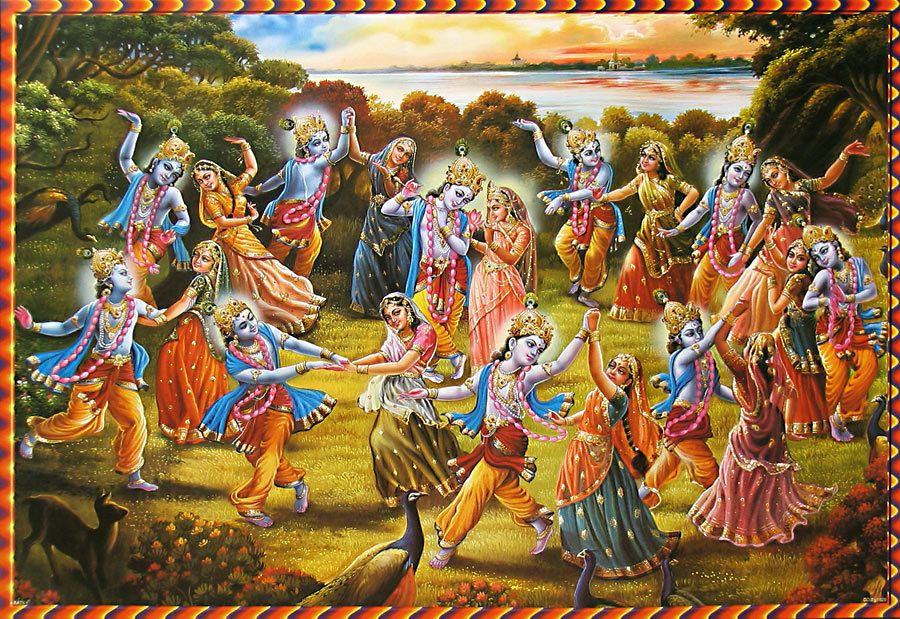In this episode, Nilanjana helps us understand the many colours and hues of love that Lord Krishna explained to the gopis of Vrindavan. It culminates in Rasa Krida, in the weekly column, exclusively for Different Truths.
Parikshit smiled, “It is so easy to keep simple folks happy.”
Sukha agreed, “Yes, the gopis were very happy that Krishna was present among them, giving them company. But then they asked him a question too.”
“What was the question?” Parikshit asked.
Sukha continued narrating, “One of the gopis asked that the world has different types of loves and different types of lovers. The first category is only capable of returning the love that is given to them. The second category can love without any expectation because it is their nature. People of the third category are a bit nonchalant – when they are loved, they do not return the affection back, nor are the affected if others do not love them. Which is the best type of love and why?
Krishna responded after a while, “The first category, in my opinion, consists of selfish people. There are focused on their own comfort and happiness. The two people who form this pair are similar. They love and show love for their own benefits.
“The second category is like the love that parents have for their children. These people are kind, full of  compassion and make very good friends.
compassion and make very good friends.
“The third category can be divided into four sub-categories. The first of these is atmarams – they are people who are self-contained. Their only joy and purpose are to revel in the Brahman; they do not expect love form others and also do not desire to give it to others. The second sub-category is aptakams – they are people whose desires have been satisfied and hence they are content. They do not hanker after anything and are hence indifferent or nonchalant. The third of these are the ungrateful ones, who are not interested in giving anything, but just keep on taking from others. The fourth one is called Gurudrohi – they have betrayed the affection of elders and are disrespectful towards them.
“As far as I am concerned, at times I do not return the love that is showered on me. That is because I want the love to be more intense. For example, if a poor man suddenly gets a lot of wealth and then loses it, will his desire for wealth not be more intense than before? I vanished from your sight some time back because I wanted to know how indispensable I am to you all. However, that agony of losing me has made your devotion more intense. I am very touched by your love and your selfless devotion to me.”
your devotion more intense. I am very touched by your love and your selfless devotion to me.”
Krishna then led the gopis to Rasa Krida. The gopis stood in a circle and Krishna danced with each of them. They all sang together. The sky was crowded with celestial beings who wished to watch this rare divine revelry. It is said that as the tempo of the dance grew faster, the planets halted their movement to witness the revelry and hence this night was longer than other full moon nights. Krishna then entered the waters of the river Yamuna with the gopis.
The long, long night came to an end only when the Sun made his presence felt in the east. Krishna requested the unwilling gopis to go home. However, there were no angry family members waiting for them. Through his yogic powers, Krishna had made them fall asleep and they were unaware of the absence of these women from their homes. The lovely night was soon a memory that the gopis re-lived again and again in their minds.”
Pariskhit said after a while, “I am still not convinced how Krishna, who is a sampurna avatar (complete incarnation) of Lord Vishnu, could indulge in such an act. Is he not the role model who was supposed to establish dharma (righteousness) in this world? How could he make love to the wives of other men? If ordinary people do this, will this be acceptable? You had told me earlier that he is an aptakarma (he has no desires) so these revels mean nothing to him. But can this act be morally justified? “
Sukha responded, “You are looking at this act like an ordinary human being. From that perspective, it may look inappropriate. The selfless devotion that the gopis had for Krishna was reciprocated in a way that they could understand. They were simple folks and would perhaps be able to understand the physical aspect of the love better. If a woman is devoted to the Divine and thinks about him day and night, would she be unfaithful to her husband? In the end, anyway, the union with the Divine is what will liberate us. As far as the gopis are concerned, Krishna decided to reciprocate their devotion in a way that they would appreciate. Hence they were gifted with oneness with him that moonlit night. Though to the ordinary person it might look like a lustful revel, it was the utmost realisation of bhakti (devotion) experienced by the gopis.”
[To be continued]
Footnote: Srimad Bhagavatam is often called the Bhagavad Purana. Authored by Ved Vyasa, the stories are about the various avatars(incarnations) of Lord Vishnu, also known as Narayana. These stories are narrated by Ved Vyasa’s son Sukhadeva to King Parikshit.
©Nilanjana Dey
Photos from the Internet
#RasaKrida #TypesOfLove #TimeWithKrishna #GopisAndKrishna #Narayana #VedVyasa #StoriesOfKrishna #AvatarsOfVishnu #MythAndMythology #DifferentTruths







 By
By

 By
By
 By
By